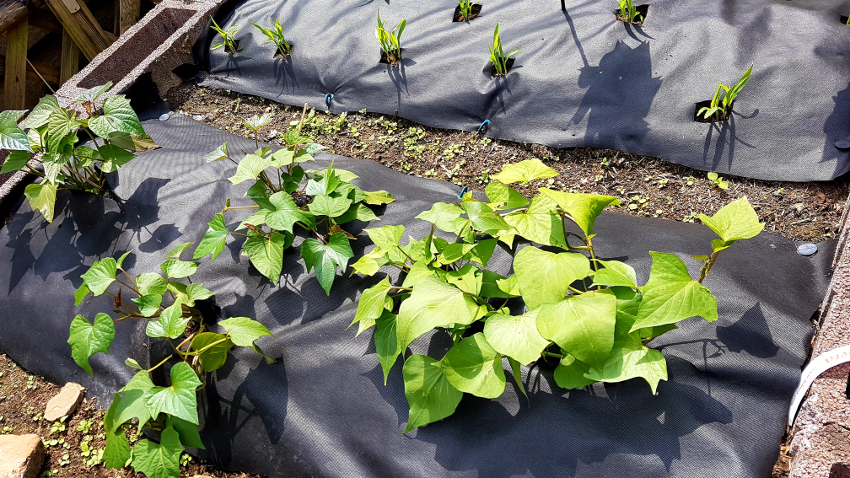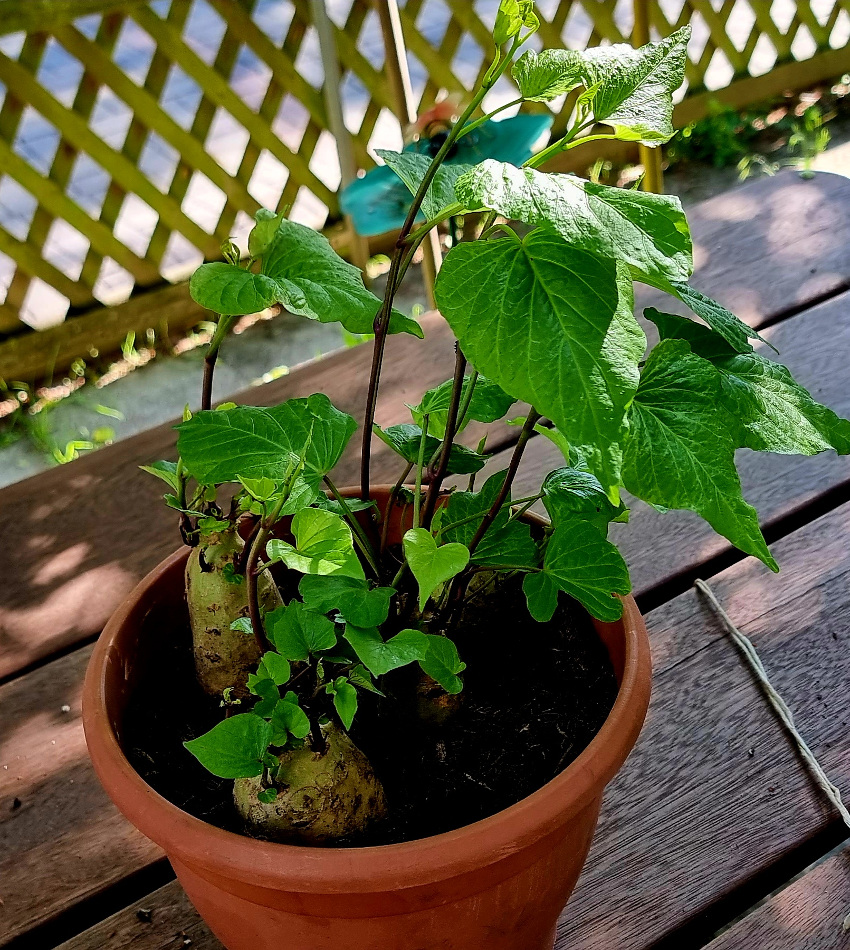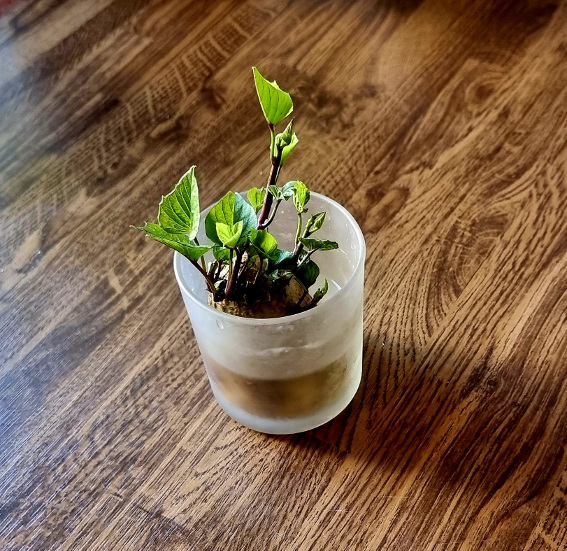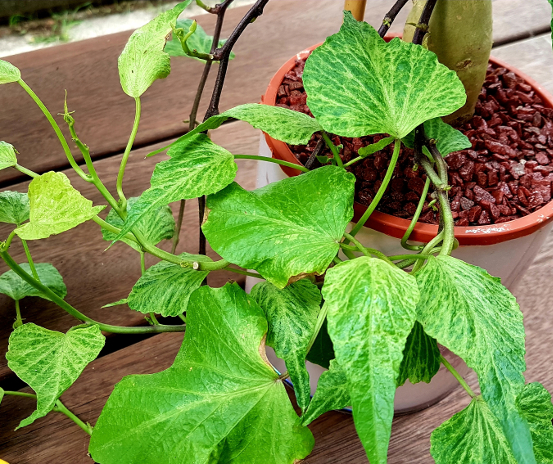A herbaceous, perennial, delicious, multipurpose, and easy-to-grow plant that comes in different species, colors, shapes, and sizes is the Sweet Potato (Ipomoea Batatas). The sweet potato is a crawling vine that can grow up to 2 meters long while producing adventitious roots. It’s composed of green vinaceous leaves that may vary slightly in shape (heart-shaped or palmate lobe leaves). In the western world, your most prominent edible root is highly available in orange, but others exist in yellow, orange, red, brown, purple, and beige.

My encounter with other sweet potato variety
The truth is, I wasn’t aware orange-looking sweet potatoes existed until after I moved to Europe. After tasting it, I realized that it was more moist and sweet than the ones I grew up eating with Avocados. It was fun trying a different species of sweet potatoes. I also realized that I prefer a slightly dehydrated consistency of some sweet potato species more than the watery ones, which were rather hard to find. As a passionate gardener, I decided to propagate and grow them in our garden.
At first, it was less challenging because I was acquainted with the process, except for my encounters with Fungus Gnats, the unpredictable German summers, and my long search for certified sweet potato slips or roots.
Topics Touched
Origin of Sweet Potato (Ipomoea Batatas)
How to Grow Sweet Potatoes At Home
Frequently Asked Questions
Pest And Diseases Associated With Sweet Potatoes
Other Species Of Sweet Potatoes
Origin of Sweet Potato (Ipomoea Batatas)
Sweet potatoes originated about 500 years ago in Central America between the Yucatan Peninsula of Mexico and the mouth of the Orincono river in Venezuela. However, radiocarbon dating tells us that other varieties from Peru existed 800 years ago.
Around 2500BCE, the locals of Mexico probably brought it to the Caribbeans, South America (Polynesia), and it only arrived in Europe during the Columbian exchange affairs. Today, Sweet potatoes are grown not just for consumption and livestock but also for industrial use and as a nutritional supplement. Most agricultural sweet potato proceeds come from Asia (China, Vietnam, Indonesia, Japan, India, Philippines), Africa (Nigeria, Uganda, Tanzania, Burundi, Mozambique, Angola), and the USA and South America.
How to Grow Sweet Potatoes At Home
Sweet potatoes are sensitive to Aluminium toxicity, but they are generally easy to cultivate, so don’t overthink and let this read-up guide you.
To proceed, you first need to decide whether to grow your sweet potatoes from slips (slips are young shootings from a mature sweet potato root) or vine cuttings. From personal experience, your success rate doubles if you grow them from certified sweet potato slips. If you choose to grow and propagate the slips, there are two straightforward methods available:
- Soil method
- Water method
A. Method One
- Soil Method: (Straightforward and my favorite !)
You’ll require a seeding container, a certified sweet potato tuber, and some moisture-retaining soil.
Pro-Tip
Please buy certified sweet potato root tubers from a trustworthy dealer with visible sprouts like the eyes on Irish potatoes which you have stored at home for long periods of time.
Procedure
- Fill half of your seeding container with a good quality moisture-retaining seeding medium and place your sweet potato into it with the eyes facing upwards.
- Cover half of the sweet potato with your medium, ensuring it’s firmly secured.
- Water thoroughly and place in a terrarium or cover the top with a thin transparent foil or polythene bag (if you cover the top with a plastic foil, puncture tiny holes to enable air circulation and prevent the growth of mold).
- Store it at a temperature above 20°C for four to six weeks, and water consistently until young vines start lengthening. The part buried in soil will develop roots, and the other exposed section will produce young, tender slips ready to be propagated or transplanted.
- At this point, you can decide to wait a week to two for your slips to grow longer while you prepare and fill your high beds or containers with well-draining gardening soil.

B. Method Two
2. Water Method (It’s fun to watch the roots develop !)
This method is similar to the soil method, except that you’ll be able to watch your plant grow roots. Isn’t that awesome ?
You’ll need a jar of water (rainwater will be great), toothpicks, and a certified healthy sweet potato root.
Procedure
- Fill your jar with rainwater and submerge half your potato tuber with the nodes facing upwards. If your container is too large, use toothpicks to suspend it from both sides.
- Cover the top with a polythene bag or plastic foil and store in a warm area (above 20°C). Remember to puncture holes in your plastic foil to enable air circulation.
- Refill your propagation jar with water when necessary, and wait four to six weeks for young slips to grow.
- Transplant into your high bed or container during the summer months when temperatures are above 18°C (sweet potatoes grow best in temperatures above 20°C) OR propagate young slips in the water and wait for roots to emerge before transplanting them.
After your slips have matured, you’re probably all set and ready to transplant your tender cuttings to a high bed, vertical garden, or container. Still, there are some vital steps that you must follow to maximize your yields and ensure your success.

Growing Sweet Potatoes
- Wait for the ideal temperature. Sweet potatoes grow best at an average temperature of 24°C, with abundant sunshine, rainfall, and warm nights. If you reside in a temperate region and don’t have a grow house, it’s wise to wait until the end of May or June when temperatures are above 18°C before transplanting your slips.
- Prepare your raised bed, gardening space, or container ahead of time. Sweet potatoes grow well in different farming conditions but will do better in aerated, well-draining loamy or sandy soil with a pH ranging between 4.5 – 7.0. Well-draining mediums are available online and at your local gardening shop, or you could combine 50% perlite or vermiculite with a planting medium. Also, fill your high bed with enough soil so that the roots have enough room to spread and produce large sweet potatoes.
- Plant in full sun to half shade
Early summer months are often misleading because warmer daytimes don’t necessarily mean warm nights, so it’s better to wait for temperatures to increase before transplanting your young sensitive sweet potato slips in your outdoor garden. In addition, the soil needs to be at least 18°C – 20°C warm to ensure that young cuttings smoothly acclimate.
- Water cohesively and provide drainages
As children, we transplanted the vines of mature sweet potato plants between mid-March and May. Around this time, Cumulonimbus Clouds shower us with moderate to heavy rainfall, with the sun popping now and then from the sky to perform its magic. Nature’s symbiotic rhythm indeed.
September, October, November, till January are usually the perfect harvesting months.
Tip
If you’re growing your sweet potatoes in flat, raised beds instead of ridges, please always provide drainages, and stop watering when yielding time is approaching.
Use a black mulch to increase the warmness of the soil.
- Take out any unnecessary weed
Weeds could be advantageous to your garden because some could attract lady beetles that feed on leaf louse and other important microorganisms that aid in decomposing organic matter and fix nitrogen for plant uptake. On the other hand, some weeds could attract unwanted pests and diseases. To prevent this, always keep a close eye on what the last bird or the wind disseminated.
- Apply fertilizer to increase yields
Consider feeding your sweet potato root tubers with a qualitative fertilizer rich in phosphorous and potassium. You might apply nitrogen-based fertilizer in smaller amounts if you wish to boost the growth of its decorative leaves.
In a nutshell, the fertilizer ratio for sweet potatoes should more or less be 10-10-5 (10: phosphorous, 10:potassium, 5:nitrogen).
Frequently Asked Questions
When should I fertilize my sweet potato ?
Sweet potatoes are gracious plants, but some additional help will do them good. Feed them three or four times during their growth phase.
The first fertilizer application is usually between two to three weeks after transplanting. Continue side-dressing the plant with composed kelp meal, bone meal, or seaweed, rich in nitrogen, phosphorous, potassium, and calcium.
An alternative is a suitable commercial fertilizer containing higher amounts of Phosphorous (P), Potassium (K), and smaller doses of Nitrogen (N) or a slow-release fertilizer.
Pro-Tip
Disperse solid fertilizers on the side and not directly on the plant to prevent foliage burns.
If you’re using a high-quality soil medium, please apply the fertilizer sparsely.
Help ! My sweet potato leaves are turning yellow !
Well, let’s keep our fingers crossed and our hopes high ! I can relate to your frustration when the edible, delicious leaves suddenly start to turn yellow before their roots mature.
The presence of pests may account for the yellowing in the leaves of your sweet potato plants, but what if this problem presents itself although your garden is void of them ?
It may often be a magnesium deficiency, which frequently occurs in leached soils or when potassium levels are excessive. The good news is: It’s easy to diagnose and revive plants suffering from the deficiency.
Older leaves are also more susceptible than younger ones, as the veins of the leaves will stay green while other parts gradually turn yellow, resulting in necrosis (death of the tissue).
How to Revive a Magnesium-Deficient Plant
Dilute a tablespoon of salt in 10 liters of water, and foliar feed the plant using a misting or spray can OR water the plant with the diluted solvent.
How often should I water my sweet potato plants ?
Newly transplanted sweet potato slips prefer moist conditions until around the fourth week. After fully establishing, they could easily tolerate drought, but you need to quench their thirst when it’s necessary. Pause your watering routine for four to six weeks when harvesting is approaching to avoid root rot.
Help ! My sweet potatoes are skinny !
Sweet potatoes need healthy soil, but not one bombarded with fertilizer, especially not nitrogen. If you’re growing sweet potatoes for their edible leaves, nitrogen-rich fertilizers will enrich your soil. K and P should be dominant in your soil if your wish to grow healthy sweet potato roots.
How can I tell when it’s time to harvest my sweet potatoes ?
If you reside in a temperate region, you can harvest sweet potatoes when the leaves start turning yellow or before the first frost. Assuming you grafted your slips in June, your root will probably be ready for harvest in October.
As kids, I can still remember when we harvested and baked freshly harvested sweet potatoes on my mom’s farm after the harshness of the harmattan winds and dry season ripped us off our energy.
In other words, if you reside in a tropical area, you can always harvest your sweet potatoes after two months post-planting. Or wait until the eighth or ninth month (during the dry season) while hoping that the wild jumpy rabbits and mice didn’t celebrate a feast before your arrival. 🙂
Can I grow sweet potatoes in a pot ?
Yes, you can grow sweet potatoes in pots on your patio or terrace. Keep in mind that they require space and sunlight to produce long and flourishing vines. Furthermore, as root plants, they need a loamy and an aerated soil to grow best.
Why aren’t my sweet potato vines flowering ?
If the sunshine exceeds 11 hours, your sweet potato plant unfortunately won’t be able to produce gorgeous pink-purplish sympetalous blooms.
How to harvest sweet potatoes ?
I believe this is the fun part of gardening – harvesting time ! Your hands, garden fork, or machete are all you’ll need.
First, get rid of the dried-out potato vines, then carefully dig and soften the soil around the potato with the help of a garden fork or machete and use your hands to get rid of excess soil. Without injuring the root, pull it out and cure it before consuming or storing it.
How to Cure and Store Sweet Potatoes
Yeap, you need to cure your sweet potato roots to increase their lifespan and flavor. Unlike most vegetables that taste great fresh, sweet potatoes taste better when left to rest for abit. You could eat them immediately, but they taste better after resting in the sun for ten days.
After harvesting, gently get rid of the excess soil from their sensitive skin and let it rest in the garden for a few days if the weather is sunny. Alternatively, you can store it in a dry corner where humidity levels range between 80% – 95% and temperatures between 28°C – 32°C.
Pro-Tip
Temperatures ranging from 13°C – 15°C with a relative humidity of 90% will increase the lifespan of your cured sweet potatoes from six to thirteen months.
Supplement with humidifiers during the winter months when the heaters are on.
What can I do to maximize my sweet potato yields ?
It may sound too good to be true, but you will yield more if you mulch your sweet potatoes and free them from unwanted weeds.
The right fertilizer, a conscious watering routine, and a top-grade planting medium are central in healthy plant growths, but a weed-free garden will increase your yields and reduce the spread of pests and pathogens.
Pest And Diseases Associated With Sweet Potatoes
Do we all agree that ‘One man’s food is another’s poison?’ Maybe!
Sweet potatoes are relatively robust plants, but daring pests and diseases like sweet potatoes weevil, whiteflies, and sweet potato virus (SPV) sometimes smuggle their way inside.
Without delay, let’s begin with the most notorious sweet potato destroyer.
Sweet Potato Weevil (Cylas Formicarius)
Sweet Potato Weevils, also known as Cylas Formicarius is a blackhead ant-like bug made up of a thorax, antennae, and legs that look reddish to orange with metallic blue elytra and abdomen. They cause more than 97% loss in both the fields and storage areas, thereby ranking high on the lists of sweet potato destroyers. Unfortunately, your sweet potato plant may show minimal or no symptoms after a weevil invasion. Adults feed on the tubers while poking numerous holes for the larvae to infest. Infested tubers could appear spongy, dark, and riddled with larvae. In most cases, the vines of the sweet potato will turn yellow, and you’ll likely observe a drastic decrease in your yields.
Other species of the Sweet Potato Weevil:
- Cylas Formicarius is native to the Caribbean, southern United States, and Asia.
- Cylas Brunneus and Cylas Punticollis are both native to sub-Saharan Africa.
Silverleaf Whitefly (Bemisia Tabaci)
So tiny but can inflict lots of damage: They are small flies with slim pale-yellow bodies, two pairs of white, waxy powder wings, and red compound eyes that spread diseases and destroy crops and flowers. They occur worldwide but predominantly in the United States, Australia, part of Asia, and Africa. Silverleaf whiteflies damage plants by spreading diseases, sucking the sap from the foliages of host plants, which leads to leaf chlorosis (paling or yellowing of leaves), premature dropping of leaves, fall in yields, and possibly plant death.
Furthermore, the tiny flies also secrete a sticky, honeydew substance that instigates sooty mold growth that can reduce the plants’ ability to absorb sunlight and cause more damage to the plant.
Plants highly susceptible to it include sweet potatoes, okra, squash, tomatoes, poinsettia, cucumber, eggplants, beans, and cotton.
How to Control the Spread of the Silverleaf Whitefly
Diluted natural oils like soybean, peanut, olive, and castor oils, effectively reduce the population of the Bemisia Tabaci. Oils extracted from the seeds of the sugar apple will also keep their spread under control by shrinking the size of the nymph resulting in detachment from the plant, starvation, and death.
- Spacing Highly Susceptible Plants
Cultural control methods like using different planting areas will reduce the spread of pests. For example, it’s thoughtful to maximize space when growing crops like the Cucurbitaceae family (cucumbers) and family Fabaceae (beans) in the same area by providing poles for the vines to grow on. Preferably, you could use reflective silver or aluminum mulch instead of plastic or fiber ones because they repel adult whiteflies.
- Use LED Light Traps
Thanks to plant physiologists Chang-Chi Chu and Thomas Henneberry, gardeners can control whitefly populations by turning on their green-emitting LED light traps in grow houses. They work best at night, are inexpensive, and are not harmful to other predator insects like ladybugs.
- Use Trap Crops or Sacrificial Crops
It pays to sacrifice a few to gain more ! This is especially true if you want your vegetable garden to flourish and be free from invasive whiteflies and other pests like snails, caterpillars, aphids, and leaf louse. For the most part, however, if you want to create a trap crop garden, you need to grow vegetables that target specific pests or a variety. For example, if you aim to trap whiteflies, leaf lice, and aphids, your sacrificial crop garden will compose of squash plants, stinging nettles, and Nasturtiums. You can always include other plants if need be.
- Use Natural Enemies
Commercially available Predators like the Delphastus pusillus will most likely aid you in eradicating whiteflies. A rather pretty small, shiny black lady beetle that can prey on adult whiteflies and devour up to 160 eggs or 12 mature nymphs daily. Fungal pathogens spore solutions in conjunction with insecticides will also reduce the populations of whiteflies. Paecilomyces Fumosorosea fungal pathogen proves to be the most efficient because it kills whiteflies at all stages of development (eggs, nymphs, pupae, and adults).
Sweet Potato Virus
Sweet potato virus is an aggressive disease (SPVD) commonly spread by the Silver Whitefly and caused by co-infection by aphid-borne sweet potato feathery mottle virus (SPFMV) and whitefly-borne sweet potato chlorotic stunt virus (SPCSV). Sadly, one could label it the sweet potato pandemic because of the worldwide yield losses it incurs.
Noticeable symptoms include leaf chlorosis, distortion, puckering, stunting, discoloration, and deformity. A single infection with SPFMV shows little, mild to no symptoms, while SPCSV infections can lead to a 43% loss in yield, mild chlorotic mottle in the center of the leaves, yellowing, and purpling of older leaves. On the other hand, dual infections with both viruses will increase yield loss and worsen known symptoms.

How to Prevent the Sweet Potato Viral Disease
Like you, I wish such stubborn viruses didn’t exist, but they do ! So, what could you do to avoid further spread if you detect them in your garden as I did in my sweet potato propagations ?
- Get rid of the plant and sanitize the working material
Yes, that’s the first thing you need to do to avoid further spread because plant pathologists and botanists have not yet found a way to eradicate the virus. Additionally, simple hygiene and sanitization practices like cleaning work tools and sterilizing farming boats and machinery will be significant in growing an almost pest-free garden.
- Discard and burn sweet potatoes infected with whitefly-borne sweet potato chlorotic stunt virus (SPCSV). A second option is to collect and feed it to wildlife.
- Control the whitefly population
Whiteflies are known for transmitting sweet potato viruses, so precautionary steps such as misting plants with diluted oils extracted from sweet apple’s seed is an eco-friendly approach.
- Buying certified slips and planting virus-resisting cuttings
Check out NARO’s newly released sweet potato varieties for resistant options.
Fusarium Yellow and Nematodes may affect sweet potatoes, too. Please check out our complete guide to growing ginger to find out how to prevent them.
Other Species Of Sweet Potatoes

- Covington (resistant to soil rot, nematodes)
- Bayou Belle (resistant to fusarium yellow and root-knot nematodes)
- Porto Rico (could be susceptible to diseases, especially fusariums)
- Burgundy (fewer yields)
- Sumor (diminished resistance to diseases)
- Okinawa (part of the Okinawan diet)
- Hannah (less moist)
- Jewel (less prone to fusarium wilt, root-knot nematode, internal cork, and sweet potato beetle)
How to grow sweet potatoes at home
Check this out
How to easily grow ginger at home
How to prevent and get rid of pests and diseases in houseplants
A beginner’s guide on how and when to fertilize houseplants
How to grow and care for Chlorophytum comosum (Spider Plant)
References
https://www.britannica.com/plant/sweet-potato

